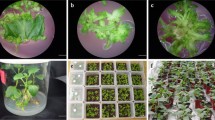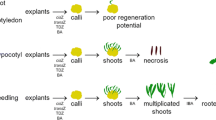Abstract
During seed germination trials of Hypericum hookerianum, seedlings of Lake View accession from Palni hills of Southern India segregated into green- (97.44 %) and red-pigmented (2.56 %) types. Seedlings cultured in Murashige and Skoog (1962) basal medium developed into fast growing green and slow growing red plant types in 6 weeks, the latter showing increased concentrations of total phenols, anthocyanins and flavonoids and 19-fold higher concentration of hypericin. Hypocotyls/cotyledons of red seedlings cultured using 2.325 μM kinetin (KIN) produced hypericin-rich (4.38 ± 0.18 mg/g DW), stunted (0.5–1.2 cm) shoots which ceased to grow in 8 weeks. Segments (4–6 mm) of these shoots sub-cultured in the dark for 4 weeks followed by 2-week light exposure and repeated subculture enabled mass multiplication of productive (3.93 ± 0.06 mg hypericin/g DW) shoots. Green hypocotyls and cotyledons subjected to 4 + 2 weak dark–light treatment also produced 9.18 ± 2.44 and 4.25 ± 0.96 comparable hypericin-rich (3.73 ± 0.21 mg/g DW) shoots. Red and green seedling explants cultured in basal medium in the dark produced 6.82 ± 0.75 cm etiolated shoots with reduced leaves which synthesized 2.27 ± 0.15 mg hypericin/g DW on illumination. Green cotyledons cultured in the dark using 2.45 μM indole-3 butyric acid (IBA) formed calluses which on illumination formed 12.64 ± 3.8 productive (3.86 ± 0.31 mg hypericin/g DW) 0.5- to 1.5-cm-long shoot clusters. Phenotypic segregation of seedlings, the ability of both red and green seedling explants to multiply in the dark and produce hypericin on illumination, and IBA-induced indirect shoots producing significant amounts of metabolite compared to wild plants (0.35 ± 0.09 mg/g DW) and green shoot cultures (0.91 ± 0.03 mg/g DW) are new to Hypericum.


Similar content being viewed by others
References
Ayan AK, Çirak C (2008) Hypericin and pseudohypericin contents in some Hypericum species growing in Turkey. Pharm Biol 46:288–291
Bacila I, Coste A, Halmagyi A, Deliu C (2010) Micropropagation of Hypericum maculatum Cranz an important medicinal plant Rom. Biotechnol Lett 15(1):86–91
Bais HP, Walker TS, McGrew JJ, Vivanco JM (2002) Factors affecting the growth of cell suspension cultures of Hypericum perforatum L. (St. John’s wort) and production of hypericin. In Vitro Cell Dev Biol Plant 38(1):58–65
Camas N, Caliskan O (2011) Breaking of seed dormancy in Hypericum leptophyllum Hochst., an endemic Turkish species. J Med Plant Res 5(32):6968–6971
Cirak C (2007) Seed germination protocols for ex situ conservation of some Hypericum species from Turkey. Am J Plant Physiol 2:287–294
Coste A, Vlase L, Halmagyi A, Deliu C, Coldea G (2011) Effects of plant growth regulators and elicitors on production of secondary metabolites in shoot cultures of Hypericum hirsutum and Hypericum maculatum. Plant Cell Tissue Organ Cult 106:279–288. doi:10.1007/s11240-011-9919-5
Cui XH, Murthy HN, Wu CH, Paek KY (2010) Adventitious root suspension cultures of Hypericum perforatum: effect of nitrogen source on production of biomass and secondary metabolites. In Vitro Cell Dev Biol Plant 46:437–444
Danova K, Nikolova-Damianova B, Denev R, Dimitrov D (2012) Influence of vitamins on phenolic content, morphological development, and stress response in shoot cultures of Hypericum spp. Plant Cell Tissue Organ Cult 110:383–393. doi:10.1007/s11240-012-0159-0
Erenpreisa J, Cragg MS (2001) Mitotic death: a mechanism of survival? Cancer Cell Int 1:1–7
Filippini R, Piovan A, Borsarini A, Caniato R (2010) Study of dynamic accumulation of secondary metabolites in three subspecies of Hypericum perforatum. Fitoterapia 81:115–119
Gadzovska S, Maury S, Ounnar S, Righezza M, Kascakova S, Refregiers M, Spasenoski M, Joseph C, Hagege D (2005) Identification and quantification of hypericin and pseudohypericin in different Hypericum perforatum L. in vitro cultures. Plant Physiol Biochem 43:591–601
Karakas O, Toker Z, Tilkat E, Ozen HC, Onay A (2009) Effects of different concentrations of benzylaminopurine on shoot regeneration and hypericin content in Hypericum triquetrifolium Turra. Nat Prod Res 23:1459–1465. doi:10.1080/14786410701664528
Karioti A, Bilia AR (2010) Hypericins as potential leads for new therapeutics. Int J Mol Sci 11:562–594
Karppinen K (2010) Biosynthesis of hypericins and hyperforins in Hypericum perforatum (St. John’s wort)-precursors and genes involved. Academic dissertation submitted to Faculty of Science, University of Oulu, Oulu. ISBN 978-951-42-6310-1
Karppinen K, György Z, Karppinen M, Tolonen A, Jalonen J, Neubauer P, Hohtola A, Haggman H (2006) In vitro propagation of Hypericum perforatum L. and accumulation of hypericins, pseudohypericins and phloroglucinols. Propag Ornam Plants 6(4):170–179
Kirakosyan A, Sirvent TM, Gibson DM, Kaufman PB (2004) The production of hypericins and hyperforin by in vitro cultures of St. John’s wort (Hypericum perforatum). Biotechnol Appl Biochem 39:71–81
Kusari S, Zühlke S, Košuth J, Čellárová E, Spiteller M (2009) Light-independent metabolomics of endophytic Thielavia subthermophila provides insight into microbial hypericin biosynthesis. J Nat Prod 72:1825–1835
Liu X-N, Zhang X-Q, Sun J-S (2007) Effects of cytokinins and elicitors on the production of hypericins and hyperforin metabolites in Hypericum sampsonii and Hypericum perforatum. Plant Growth Regul 53:207–214
Murashige T, Skoog F (1962) A revised medium for rapid growth and bioassays with tobacco tissue culture. Physiol Plant 15:473–497
Oluk EK, Orhan S, Karakaş O, Çakir A, Gönüz A (2010) High efficiency indirect shoot regeneration and hypericin content in embryogenic callus of Hypericum triquetrifolium Turra. Afr J Biotechnol 9(15):2229–2233
Padmesh P (2012) Isolation and characterization of candidate gene(s) involved in the biosynthesis of hypericins-an aromatic naphthodianthrone from Hypericum spp. PhD thesis, University of Kerala, Thiruvananthapuram
Padmesh P, Seeni S, Reji JV, Nair GM (2008) A novel process for the production of hypericin from shoot and callus cultures of Hypericum hookerianum Wight & Arn. Indian Patent No. 224656
Pavlik M, Vacek J, Klejdus B, Kuban V (2007) Hypericin and hyperforin production in St. John’s wort in vitro culture: influence of saccharose, polyethylene glycol, methyl jasmonate and Agrobacterium tumefaciens. J Agric Food Chem 55:6147–6153
Porra RJ (2002) The chequered history of the development and use of simultaneous equations for accurate determination of chlorophylls a and b. Photosynth Res 73:149–156
Savio LEB, Astarita LV, Santarem ER (2011) Secondary metabolism in micropropagated Hypericum perforatum L. grown in non-aerated liquid medium. Plant Cell Tissue Organ Cult. doi:10.1007/s11240-011-0058-9
Shaw AK, Avery BA, Wyandt CM (2005) Content analysis and stability evaluation of selected commercial preparations of St. John’s wort. Drug Dev Ind Pharm 3(9):907–916
Singleton VL, Rossi JA (1965) Colorimetry of total phenolics with phosphomolybdic phospho -tungstic acid reagents. Am J Enol Vitic 16(3):144–158
Southwell IA, Bourke CA (2001) Seasonal variation in hypericin content of Hypericum perforatum L. (St. John’s wort). Phytochemistry 56:437–441
Walker TS, Bais PH, Vivanco JM (2002) Jasmonic acid induced hypercin production in cell suspension cultures of Hypericum perforatum L. (St. John’s wort). Phytochemistry 60:289–293
Wrolstad RE, Skrede G, Lea P, Enersen G (1990) Influence of sugar on anthocyanin pigment stability in frozen strawberries. J Food Sci 55(4):1064–1065
Zhishen J, Mengcheng T, Jianming W (1999) The determination of flavonoid contents in mulberry and their scavenging effects on superoxide radicals. Food Chem 64:555–559
Zobayed SMA, Saxena PK (2004) Production of St. John’s wort plants under controlled environment for maximizing biomass and secondary metabolites. In Vitro Cell Dev Biol Plant 40:108–114
Zobayed SMA, Murch SJ, Rupasinghe HPV, Saxena PK (2004) In vitro production and chemical characterization of St. John’s wort (Hypericum perforatum L. cv New Stem). Plant Sci 166:333–340
Author information
Authors and Affiliations
Corresponding author
Rights and permissions
About this article
Cite this article
Varghese, R.J., Sooriamuthu, S. Differences in hypericin synthesis between experimentally induced seedling shoot cultures of Hypericum hookerianum Wight & Arn.. Plant Biotechnol Rep 7, 511–518 (2013). https://doi.org/10.1007/s11816-013-0289-9
Received:
Accepted:
Published:
Issue Date:
DOI: https://doi.org/10.1007/s11816-013-0289-9




